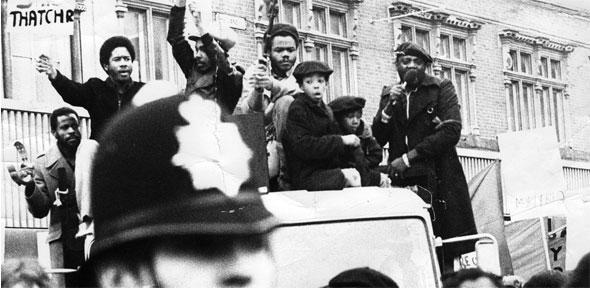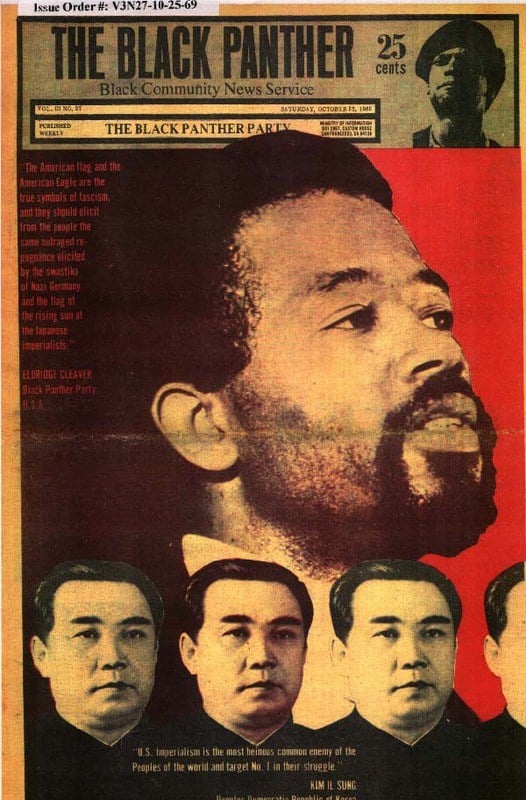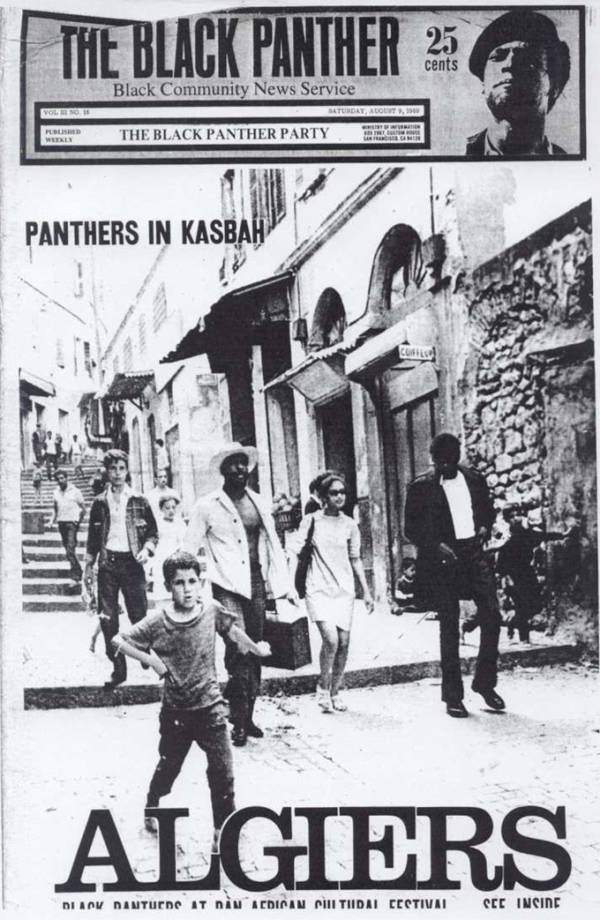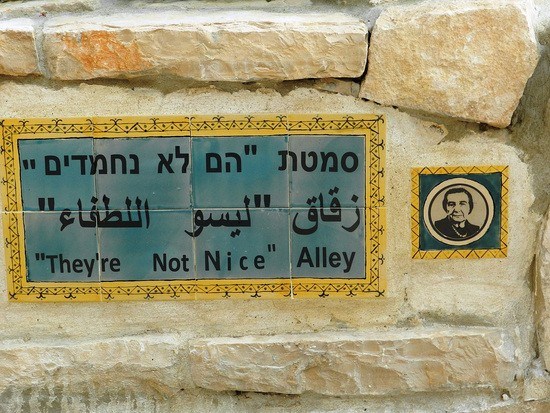By Annie Garau
England

Darcus Howe/University of CambridgeThe Black People’s Day of Action in London. March 2, 1981.
The first international branch of the Black Panther Party was formed by West African and West Indian immigrants in London, who ran the British Black Panther Movement from 1968 to 1972.
This came directly after the United Kingdom’s black population had more than tripled in a span of only three years — from 300,000 in 1961 to 1 million in 1964.
The group had minor ideological differences as well as different end goals from the American party. While UK legislation never enshrined segregation into law as it did in the US, businesses did discriminate against non-white populations, especially in the 1960s as the economy declined and jobs were scarce.
“We were a movement aiming to educate our communities and to fight injustice and discrimination,” former British Panther Neil Kenlock told VICE. “That was our mantra. America was just coming out of segregation then, while we never had it. So there was a huge difference between our problems and theirs.”
Even so, its leaders agreed with the American founders that the problem of racial discrimination was a global one that had to be fought with global cooperation.
“We do not dream for one moment that the Black people in Britain can organize themselves as a unit totally separate from other Black forces in the world,” London’s Black Power leader, Obi Egbuna, said. “Black Power is an international concept.”
India

Wikimedia CommonsDalit Panthers distributed many pamphlets and fliers such as this one.
The Dalit Panthers formed in early 1970s India. Dalit means poor or downtrodden, and the group indeed focused on the nation’s “untouchable” castes. These were people that Indian law historically excluded from society and relegated to poor-paying jobs and slums.
“Untouchability is the most violent form of exploitation on the surface of the earth,” the Dalit Panthers’ manifesto read. “Today it is necessary to seek its soil, its root causes. If we understand them, we can definitely strike at the heart of exploitation.”
Like its American predecessor, the Dalit Panther group used a militant approach to effecting cultural reform.
Unlike the Black Panthers, though, the Dalits also incorporated religion. Many Dalits believed that conversion to Buddhism could liberate Indians from the strictures of the class system, which divided people by the Hindu sects they were born into. The Panthers continued pre-existing efforts to promote mass conversions and incorporated Buddhist teachings into their doctrine.
New Zealand

PBS/YouTubeA protest of Polynesian Panthers in New Zealand.
Many Maori and Pacific Islanders in New Zealand found the Black Panthers’ ideology particularly relatable.
The Polynesian Panther Party was mainly founded by high school students whose parents had immigrated to New Zealand in the 1960s.
Faced with constant threats of deportation, inferior schools, low-paying jobs, and dangerous neighborhoods, these first-generation teenagers used the Black Panther ideology as a rallying point for change.
With homework centers, prison visitation programs, transportation organizations, and an education movement, the group focused primarily on peaceful efforts.
Their most well-known retaliation stunts, however, were the “dawn raids” they conducted in response to police brutality.
At the time, it was a common occurrence for New Zealand police to knock down the doors of Polynesian homes in the middle of the night and demand that all of the residents show their passports.
When Panthers began doing the same thing to New Zealand politicians – banging on doors and windows and shining floodlights into their fancy homes in the early hours of the morning – the police raids promptly stopped.
North Korea and China

The Freedom ArchivesEldridge Cleaver and Kim Il-sung on the cover of The Black Panther.
The Black Panther Party forged ideological and diplomatic bonds with North Korea and China, with members drawing inspiration from each government’s respective social teachings and receiving public support in return.
Eldridge Cleaver, one of the most prominent and controversial members of the American Black Panther Party, visited North Korea in 1969 in an effort to elevate the party’s political influence and international standing.
“Today, the (Democratic People’s Republic of Korea) is an earthly paradise, with an advanced socialist system, highly developed technology, a brilliant national culture and a healthy people,” he wrote. “Definitely on the move towards even greater achievements.”
The country’s leader, Kim Il-sung — who maintained terse relations with the United States government — praised the Black Panthers’ “just struggle to abolish the cursed system of racial discrimination of the US imperialists.”
The Panthers particularly took to the Korean idea of juche: “adapting ideology to fit your circumstances.”

Jack Garofalo/Paris Match/Getty ImagesA poster of Mao Zedong hangs in an office in Harlem, New York City, 1970.
Chinese communist ideology also played a major role in the American party’s development. Indeed, the American Black Panther Party mandated that each member read Mao Zedong’s “Little Red Book.”
“A revolution is not a dinner party, or writing an essay, or painting a picture, or doing embroidery,” the book reads. “A revolution is an insurrection, an act of violence by which one class overthrows another.”
In 1971, famous Panther Huey Newton led a ten-day delegation to China, where thousands of fans at every airport greeted him.
“We support the Black Panther Party, down with US imperialism,” some signs read. “We support the American people but the Nixon imperialist regime must be overthrown.”
The Panthers’ visits to both of these countries were heavily supervised, and likely gave the leaders a skewed view of what was actually a turbulent time for the Chinese and North Korean people.
Algeria

The Black Panther/It’s About TimeThe Black Panther August 9, 1969 cover featuring Cleaver surrounded by fellow Panthers and local children in Algeria.
Algeria became a symbol of hope for black people around the world when it achieved independence from France in 1962. As such, the country hosted several revolutionary movements, including the Black Panthers.
The group set up its international embassy in Algiers, where the Algerian government gave them a building, a living space, a stipend, and the ability to issue visas and grant asylum to other members of the movement.
For this reason, many Panthers who were forced to flee the United States found refuge there.
Israel

Wikimedia CommonsThe Israeli Black Panthers social movement originated in the Musrara neighborhood in the early 1970s. Then Israeli Prime Minister Golda Meir said, “They are not nice people.” This alley is still named after that quote.
In Israel, the Black Panther torch was taken up by Mizrahi Jews — Jews descended from the Middle East, North Africa, and Central Asia — along with other minority groups within the Jewish community.
The discontentment in these groups began as soon as Israel was first established.
Mizrahi Jews had left their (predominantly Muslim) home countries to seek refuge and acceptance in the new state. But when they arrived, they faced continued inequality – being relegated to inferior neighborhoods and worse-paying jobs than Jews of European decent.
So, in 1971, a group of Mizrahi and other Jews formed the Israeli Black Panthers. The party rapidly gained popularity and on May 18, 1971, they hosted a militant protest of 5,000 to 7,000 demonstrators in Jerusalem’s Zion Square.
“The Night of the Panthers” was meant as a statement against income inequality. It succeeded in getting the prime minster’s attention, and social service budgets were enlarged shortly afterward (if only for a brief moment).
